What is ASIC? Application Specific Integrated Circuits
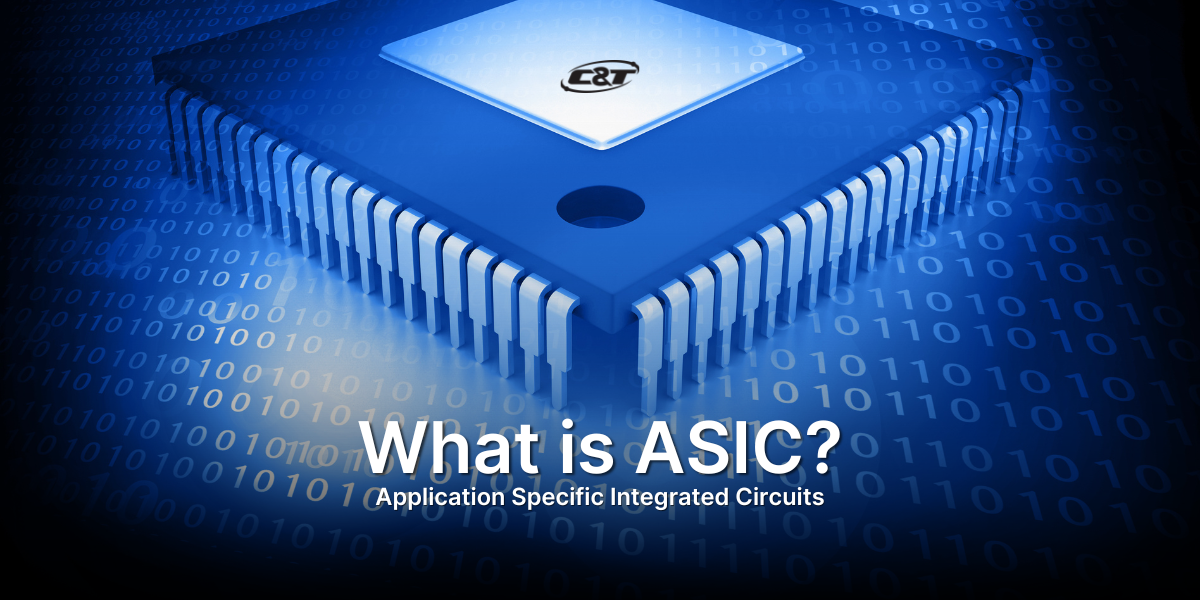
Everyone should be familiar with the term 'Integrated Circuits' (ICs), which are fundamental components in modern electronic devices. ICs come in different types and configurations, catering to a wide range of applications. Broadly, these circuits can be categorized into two groups: those designed for specific applications, and those that can be reprogrammed for various purposes. In this blog, we will delve into Application-Specific Integrated Circuits (ASICs), a type of IC that is tailored for a particular use, highlighting their design, advantages, and application areas.
What you can expect from this blog:
- ASIC Definition
- Types of ASICs
- ASIC Design Flow
- ASICs Application
- ASIC vs FPGA: What's the difference?
What is an ASIC Chip (Application Specific Integrated Circuit)?
ASICs are integrated circuits that are specifically designed and tailored for a particular application or use. Unlike general-purpose integrated circuits that can be used in a variety of devices, they are usually created from the ground up, based on the specific needs of the application they are intended for. Examples include chips found in toys or those used for the interfacing of memory and microprocessors.
Types of ASICs
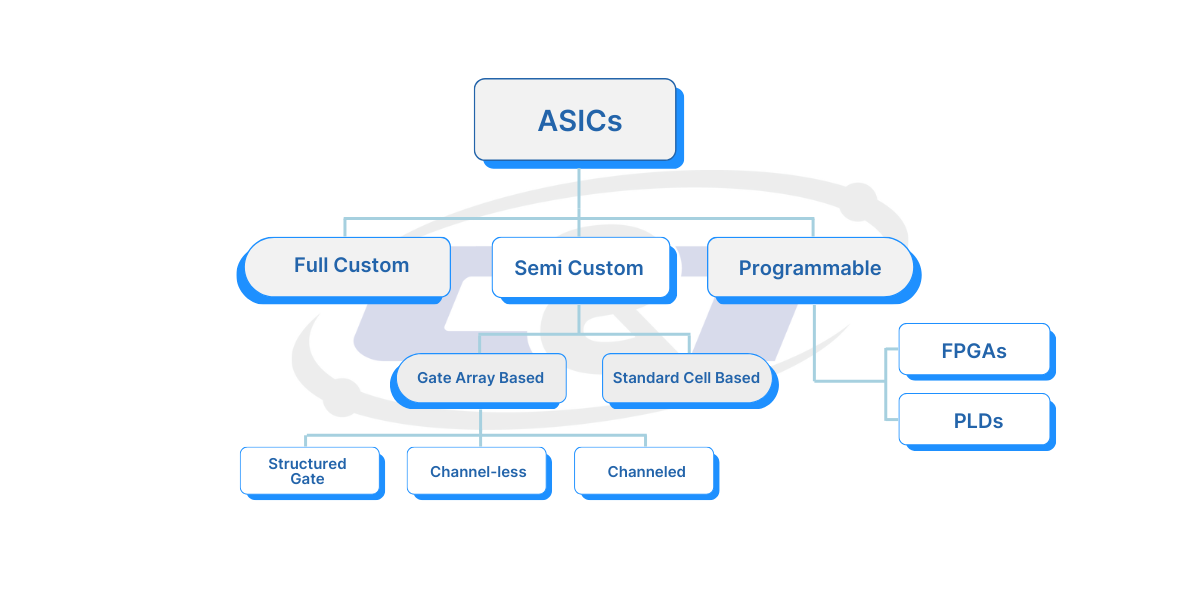
1. Full Custom ASICs
These ASICs are designed from the ground up for a specific application. Every aspect of the chip, from the logic gates to the layout of the circuit, is custom-made to meet the precise requirements of the intended application. Full custom ASICs offer the highest performance and the lowest power consumption, but they are also the most expensive and time-consuming to design and manufacture. They are typically used in applications where the volume is high enough or the performance requirements are strict enough to justify the additional cost and effort.
2. Semi-Custom ASICs
Semi-custom ASICs, including Standard Cell ASICs and Gate Array ASICs, offer a balance between customization and cost.
- Standard Cell ASICs: In standard cell-based ASIC design, a standard cell library contains pre-designed logic cells like AND gates, OR gates, multiplexers, and flip-flops. These cells are standardized and stored for use in ASIC chip designs. The ASIC chip typically includes a standard cell area or flexible block, made up of these cells arranged in rows, and may also incorporate mega cells such as microcontrollers or microprocessors, referred to as mega functions, system-level macros, or fixed blocks/functional standard blocks. The standard cell ASIC's mask layers are customizable, allowing designers to place standard cells strategically across the die, leading to efficient space utilization and optimized performance, a design approach also known as C-BIC.
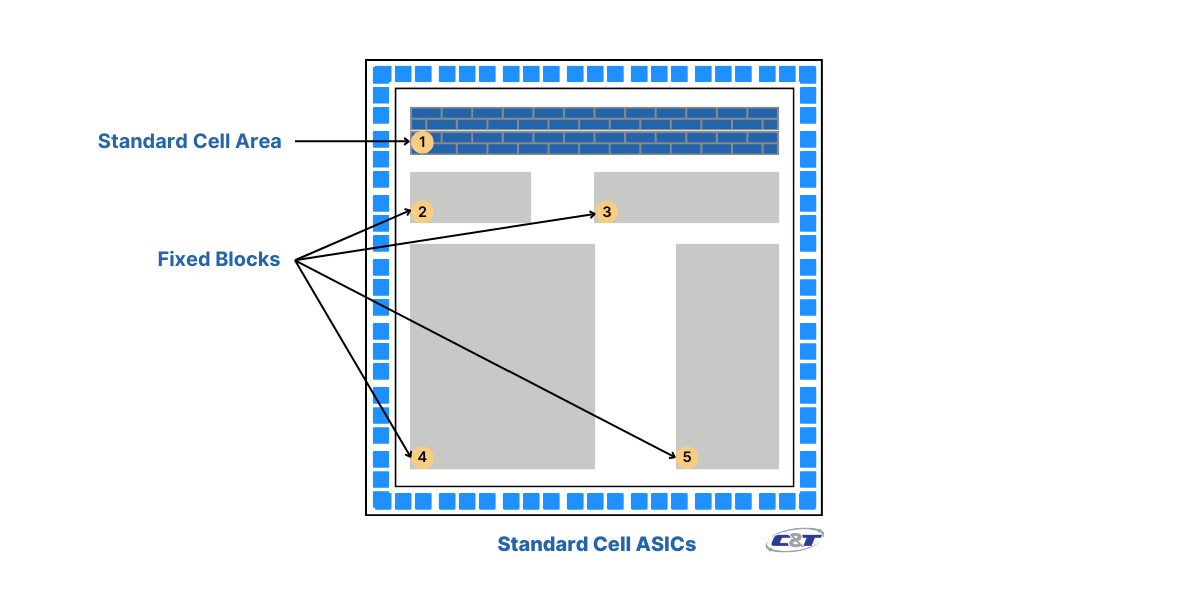
- Gate Array ASICs: Gate Array ASICs are a type of semi-custom ASIC with predefined transistors on the silicon wafer, where the designer cannot alter the transistor placement but can change the interconnections between them using the die's initial metal layers. The design utilizes a gate array library for configuration, typically resulting in Channeled, Channel-less, or Structured Gate Arrays, each varying in interconnection approach. This method, known as Masked Gate Array, relies on a base array pattern and base cells for circuit design.
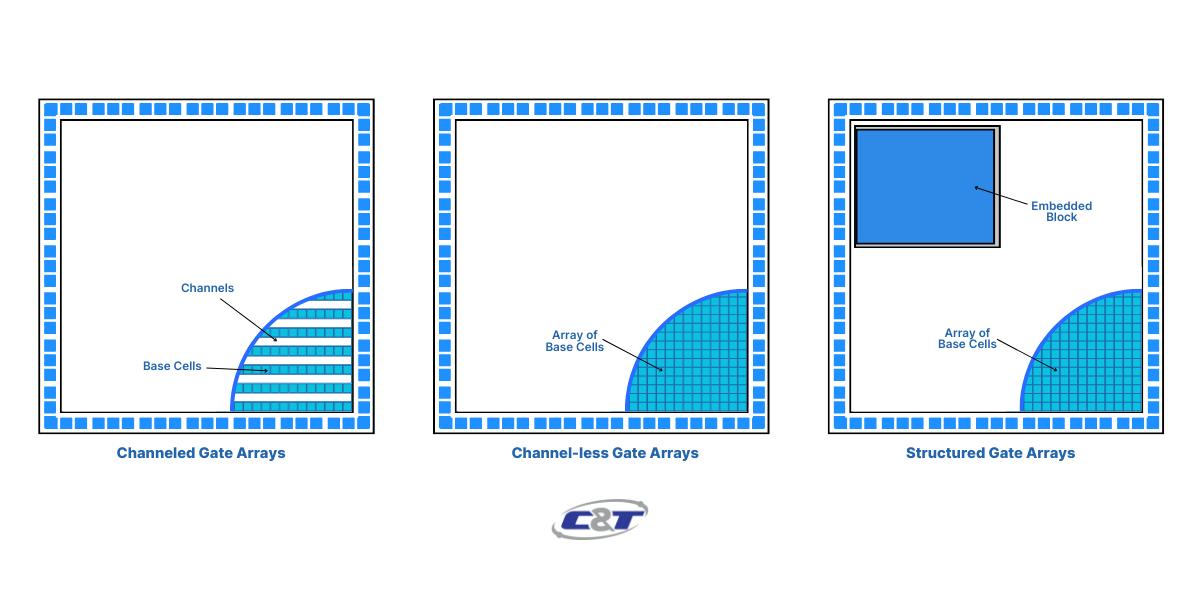
- Channeled Gate Arrays: Utilize predefined routing channels between logic cells for wire connections, suitable for standardized designs needing flexible interconnect pathways.
- Channel-less Gate Arrays: Lack predefined routing channels, allowing more compact designs by placing interconnects directly over cells, enhancing chip density.
- Structured Gate Arrays: Combine predefined logic blocks with customizable interconnect layers, offering a balance between design flexibility and rapid development.
3. Programmable ASICs
- Programmable Logic Devices (PLD): a type of digital integrated circuit that can be programmed to perform a wide range of logical operations. They are used in various applications to implement custom logic circuits without the need for custom semiconductor manufacturing.
- FPGAs: Reprogrammable and can be used for various applications. They can be configured by the user after manufacturing according to different needs. Learn more about FPGAs.
Application Specific Integrated Circuit (ASIC) Design Flow
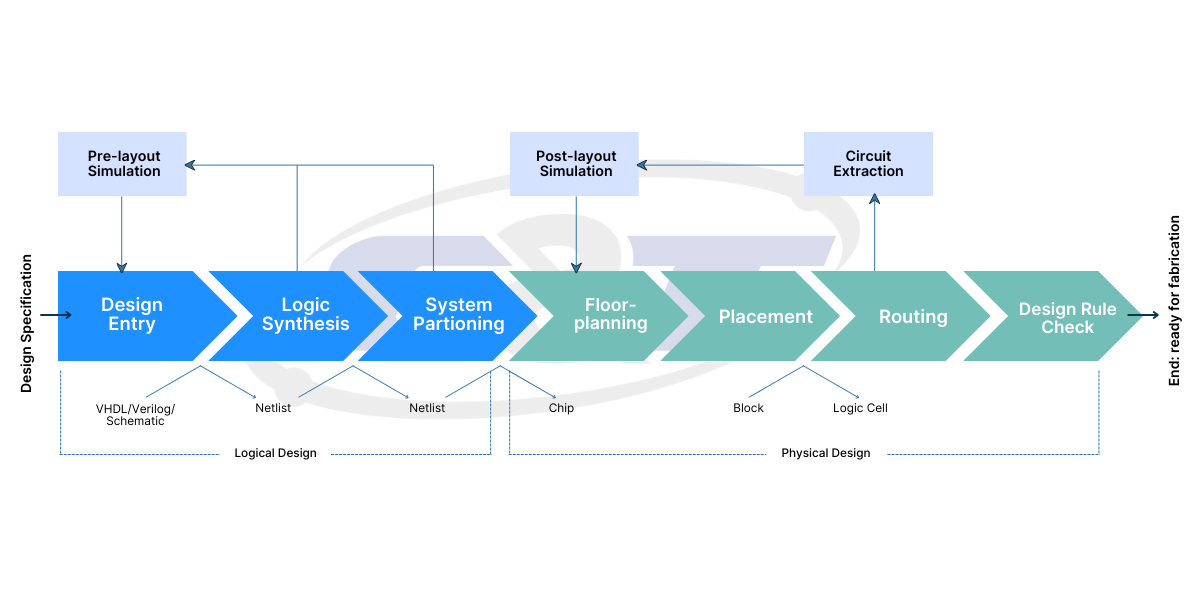
Design Entry: In this phase, the microarchitecture is developed using hardware description languages such as VHDL, Verilog, and System Verilog.
Logic Synthesis: This phase involves creating a netlist that outlines the logic cells, their interconnections, and other necessary components, all derived from the HDL code.
System Partitioning: Here, the large die is divided into manageable ASIC-sized sections for more efficient design and processing.
Pre-Layout Simulation: A simulation is conducted at this stage to identify and rectify any errors in the design.
Floor Planning: During this phase, the arrangement of the netlist blocks on the chip is determined.
Placement: This step involves determining the exact locations of cells within each block.
Routing: In this phase, physical connections between blocks and cells are established.
Extraction: This stage is focused on assessing the electrical characteristics, such as resistance and capacitance, of the connections.
Post-Layout Simulation: This final simulation tests the entire system’s functionality, including the impact of interconnect loads, before the design is sent off for manufacturing.
Advantages of ASICs
- High Performance: ASICs are custom-designed for a specific application, allowing them to achieve higher performance levels than general-purpose integrated circuits.
- Lower Power Consumption: Since ASICs are optimized for a particular use, they typically consume less power compared to other IC types performing the same tasks.
- Smaller Size: ASICs can integrate many functions into a small chip, reducing the overall size of the device.
- Reduced Cost per Unit: Although the initial development cost is high, the per-unit cost can be significantly lower for large-scale production.
- Higher Security: Customization makes it harder for others to reverse-engineer the hardware, providing an additional layer of security.
- Fewer Components: The integration of multiple functions reduces the number of separate components needed, leading to simplified construction and increased reliability.
Application of ASICs
The distinct characteristics of ASICs have transformed electronic manufacturing, leading to smaller die sizes and greater logic gate density per chip. Typically chosen for advanced applications, ASIC chips serve as IP cores in satellites, are crucial in ROM production, and are utilized in microcontrollers, as well as in a wide array of medical and research applications. Currently, one of the most notable uses of ASIC technology is in Bitcoin mining.
How do ASICs differ from FPGAs?
ASICs, or Application-Specific Integrated Circuits, are custom-designed semiconductor chips for specific tasks, making them unsuitable for general-purpose use. These circuits, once manufactured, cannot be reprogrammed. In contrast, FPGAs, or Field-Programmable Gate Arrays, feature programmable hardware, allowing flexibility and post-manufacture reconfiguration. Here is a better comparison:
| Feature | FPGA | ASIC |
|---|---|---|
| Flexibility | High (reprogrammable) | Low (not reprogrammable) |
| Performance | Lower than ASIC | Higher Performance for specific tasks |
| Power Consumption | Higher compared to ASIC | Lower (optimized for efficiency) |
| Development Cost | Low (no NRE cost) | High (high NRE cost) |
| Production Cost per Unit | Higher compared to ASIC | Lower (optimized for efficiency) |
| Time to Market | Shorter (reprogrammable, adaptable) | Longer (due to design and fabrication) |
| Reprogrammability | Yes (can change algorithms post-production) | No (fixed design) |
| Suitable Production Cycle | Small to medium scale | High volume (to offset NRE costs) |
| Design Cycle | Shorter | Longer |
In summary, the choice between FPGA and ASIC depends on the specific application requirements. FPGAs are favored for their adaptability and quick deployment, ideal for evolving environments, prototyping, and medium-scale productions requiring flexibility. Conversely, ASICs excel in efficiency, offering optimized performance and lower power consumption, making them the better choice for high-volume, stable applications where the high initial cost can be offset by large-scale production benefits. The decision between using an FPGA or an ASIC ultimately depends on factors such as required flexibility, performance needs, power consumption, and production volume.
FAQ
- What is ASIC?
ASICs are integrated circuits that are specifically designed and tailored for a particular application or use.
- What are types of ASICs?
Full custom ASICs, semi-custom ASICs, and programmable ASICs.
- What are Gate Array ASICs?
Gate Array ASICs are a type of semi-custom ASIC with predefined transistors on the silicon wafer, where the designer cannot alter the transistor placement but can change the interconnections between them using the die's initial metal layers.
- What are programmable ASICs?
One type of programmable ASICs is FPGAs.
- What is FPGA?
An FPGAs, or Field-Programmable Gate Array, features programmable hardware, allowing flexibility and post-manufacture reconfiguration.
- What are the advantages of ASICs?
High performance, lower power consumption, smaller size, reduced cost per unit, higher security and fewer components.
- Is ASIC better than FPGA?
The decision between using an FPGA or an ASIC ultimately depends on factors such as required flexibility, performance needs, power consumption, and production volume.

